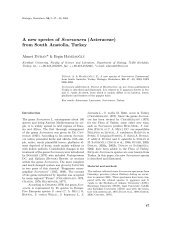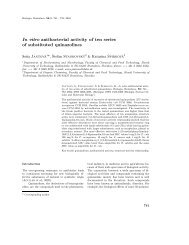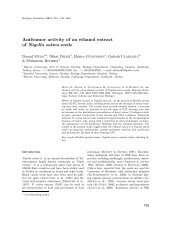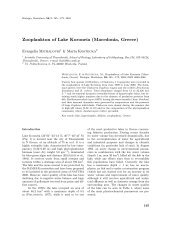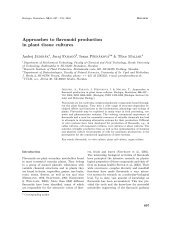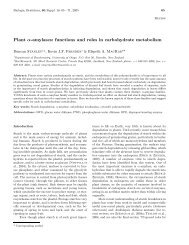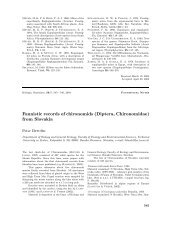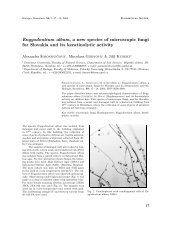Detection of Salmonella by polymerase chain reaction - Biologia ...
Detection of Salmonella by polymerase chain reaction - Biologia ...
Detection of Salmonella by polymerase chain reaction - Biologia ...
Create successful ePaper yourself
Turn your PDF publications into a flip-book with our unique Google optimized e-Paper software.
Table 1. Primers used in this study.<br />
primer orientation position 1 sequence<br />
S5 forward 224–262 AGCGAGCCCAAAAGTGAAA<br />
S6 reverse 665–646 GTCAATGCGCCGTAATCATT<br />
S212 forward 212–231 AAACGTTTATCGTTACGCCG<br />
S500 reverse 450–481 ATCTTGAGATGGTTGCCGAC<br />
1 In the fimC gene <strong>of</strong> S. typhimurium.<br />
Table 2. Specificity <strong>of</strong> the primer combinations. Reaction conditions were as stated in materials and methods,<br />
annealing temperature was 50 ◦ C.<br />
S212/S500 S5/S6 S212/S6 S5/S500<br />
Escherichia coli – – – –<br />
Enterobacter cloacae – – – –<br />
Citrobacter braakii – + – –<br />
Citrobacter diversus – + – –<br />
Citrobacter freundii – + – –<br />
<strong>Salmonella</strong> typhimurium + + + +<br />
<strong>Salmonella</strong> arisonae + – + –<br />
<strong>Salmonella</strong> detection in foods<br />
Food products were purchased from local retail stores.<br />
A method according to ISO 6579 (1993) was used as<br />
the reference one; all media were from Merck (Darmstadt,<br />
Germany). Samples (25 g) were homogenized in<br />
the buffered peptone water (BPW; 225 mL) and incubated<br />
at 37 ◦ C for 16 h. A volume <strong>of</strong> 0.1 mL <strong>of</strong> the<br />
culture was inoculated to 9.9 mL <strong>of</strong> the Rappaport-<br />
Vassiliadis medium, another 1 mL to 9 mL <strong>of</strong> the<br />
selenite-cystine broth, and the cultures were incubated<br />
at 41 ◦ C and at 35 ◦ C, respectively, for 7 h. Subsequently,<br />
aliquots <strong>of</strong> 1 mL were withdrawn from the<br />
selective media and subcultured in LB broth at 37 ◦ C<br />
for 16-18 h. Volumes <strong>of</strong> 1 mL <strong>of</strong> the culture in BPW,<br />
or <strong>of</strong> the two cultures in LB, were used for the lysis<br />
and PCR. For the three-step enrichment, samples<br />
were considered positive when at least one <strong>of</strong> the two<br />
LB cultures gave rise to a positive result.<br />
Results<br />
Design <strong>of</strong> the primers<br />
Three fimbrial sequences accessible in the database<br />
were compared: fimC <strong>of</strong> S. typhimurium (L19338),<br />
fimC <strong>of</strong> S. typhi (X74602), and sfmC <strong>of</strong> E. coli<br />
(AE000159). The last sequence was found to be <strong>of</strong><br />
a higher homology with fimC <strong>of</strong> <strong>Salmonella</strong> than<br />
fimC <strong>of</strong> E. coli. Based on this comparison, four<br />
primers were designed (Tab. 1). Primers S212 and<br />
S500 were selected to be <strong>Salmonella</strong>-specific, while<br />
primers S5 and S6 were conservative for all the<br />
three genes considered.<br />
Evaluation <strong>of</strong> the primers<br />
Specificity <strong>of</strong> the primers was tested on a number<br />
<strong>of</strong> bacterial strains (Tab. 2). The primer combination<br />
S212/S500 was specific for the genus<br />
<strong>Salmonella</strong> in a broad interval <strong>of</strong> annealing temperatures<br />
(46–58 ◦ C). The primer combination<br />
S5/S6 amplified a defined DNA fragment at a<br />
medium annealing temperature (50 ◦ C) not only<br />
from <strong>Salmonella</strong> spp., but from Citrobacter spp.<br />
as well. When the annealing temperature was increased<br />
to 58 ◦ C, the stringency improved and amplification<br />
took place only for <strong>Salmonella</strong> spp. On<br />
the other hand, S. arizonae was not detected with<br />
this primer combination at given <strong>reaction</strong> conditions.<br />
Based on these results, the primer combination<br />
S212/S500 was chosen for further work.<br />
Sequencing the PCR products<br />
Identity <strong>of</strong> the PCR product was confirmed <strong>by</strong><br />
sequencing. The sequence <strong>of</strong> the PCR product<br />
from S. typhimurium 34 was identical to that in<br />
the GeneBank (L19338), the sequence <strong>of</strong> the PCR<br />
product from S. enteritidis 173 differed only in one<br />
nucleotide (data not shown).<br />
Specificity <strong>of</strong> <strong>Salmonella</strong> detection<br />
The specificity <strong>of</strong> the primer pair S212/S500 was<br />
further tested on a panel <strong>of</strong> <strong>Salmonella</strong> and non-<br />
<strong>Salmonella</strong> strains. All <strong>of</strong> 53 <strong>Salmonella</strong> serotypes<br />
tested (95 strains) gave a positive signal in the<br />
PCR analysis. No product was amplified with<br />
613



